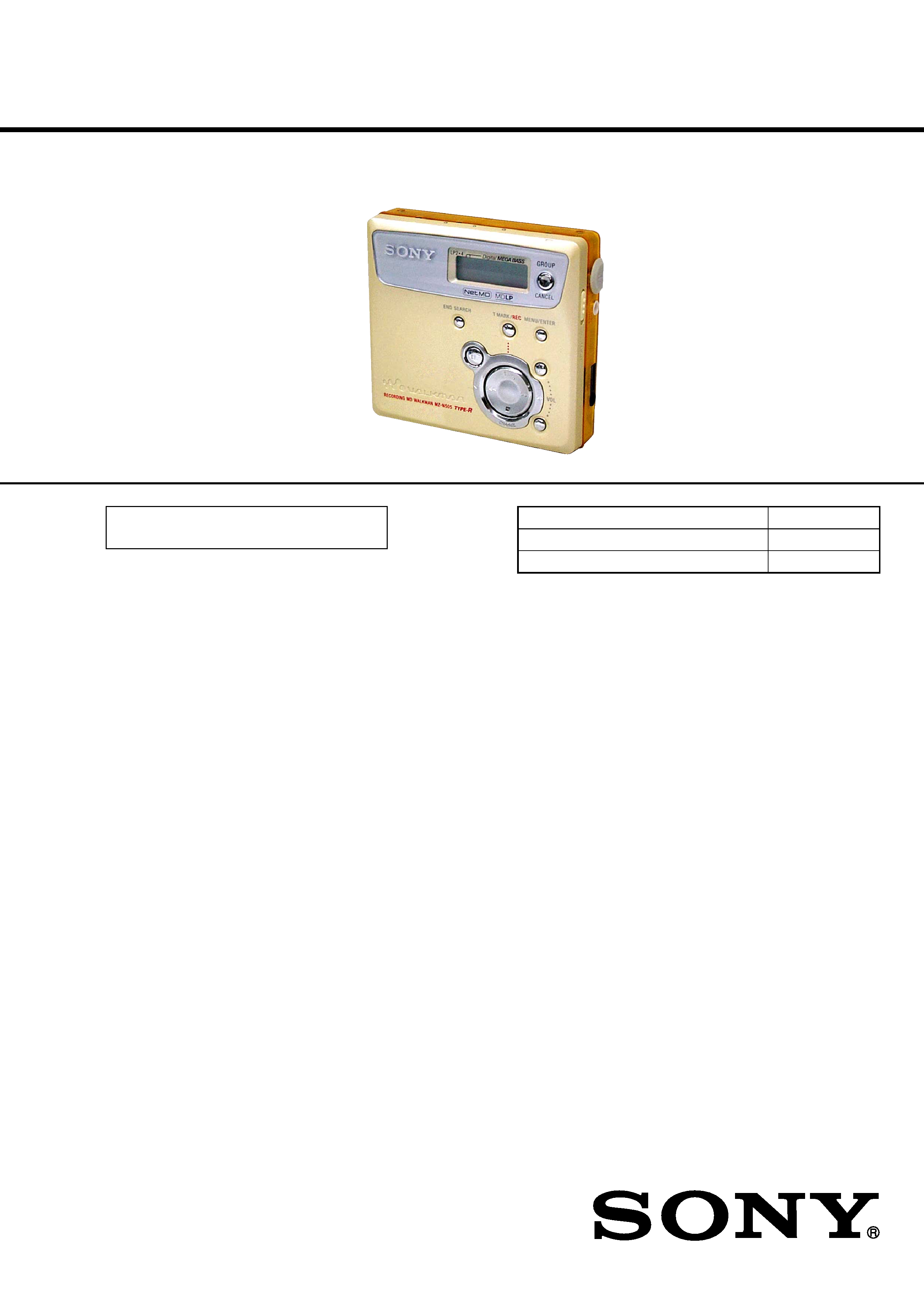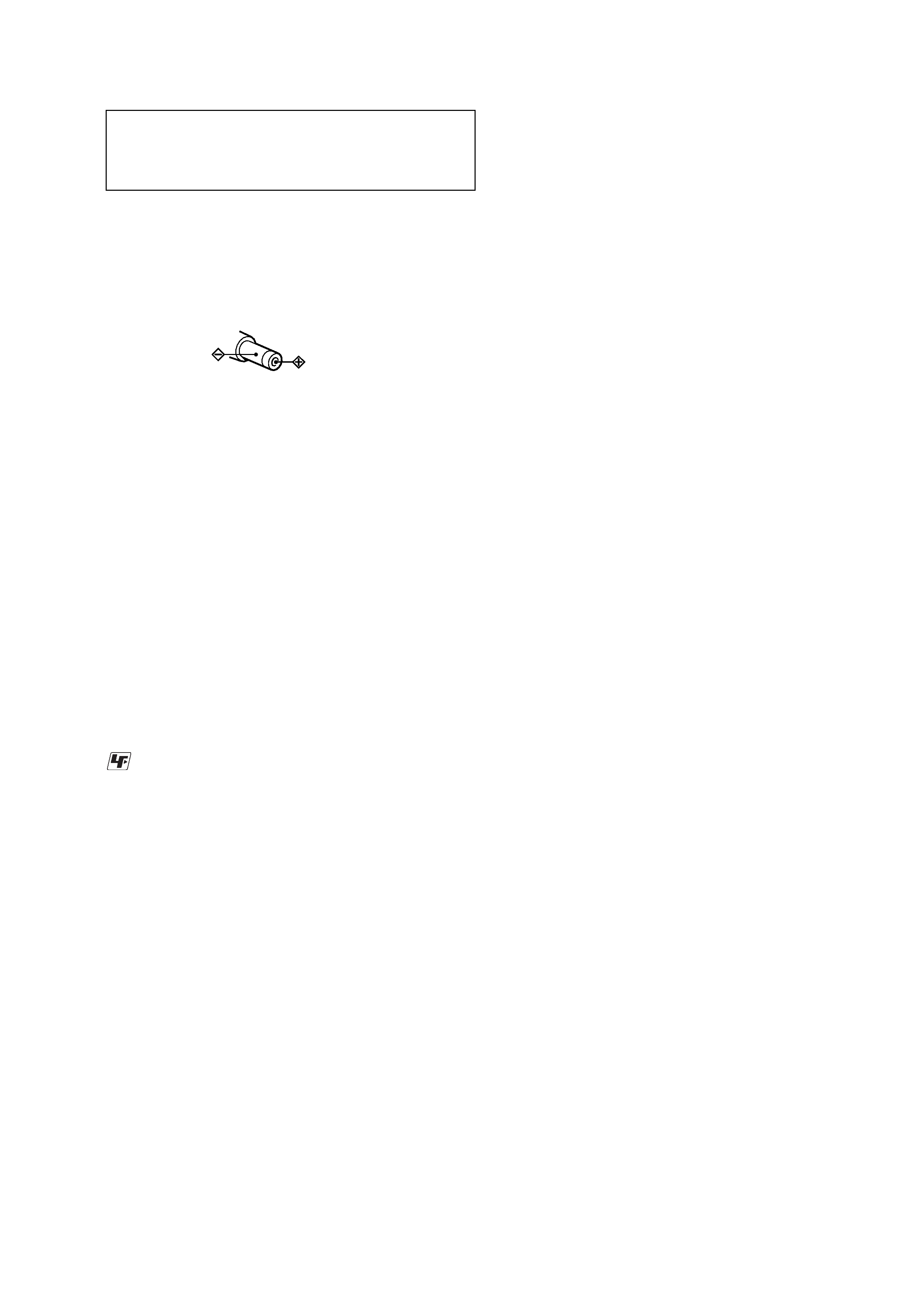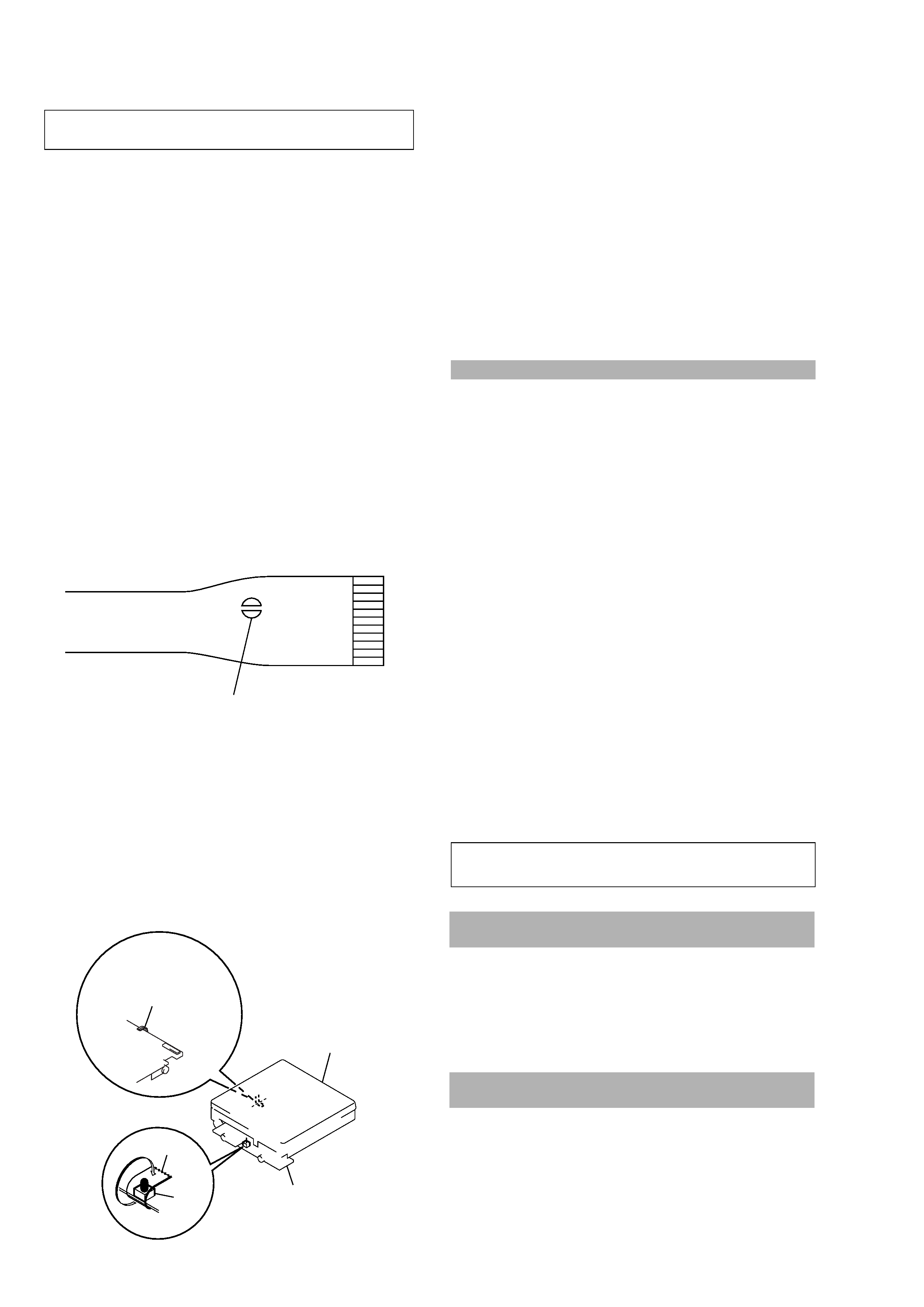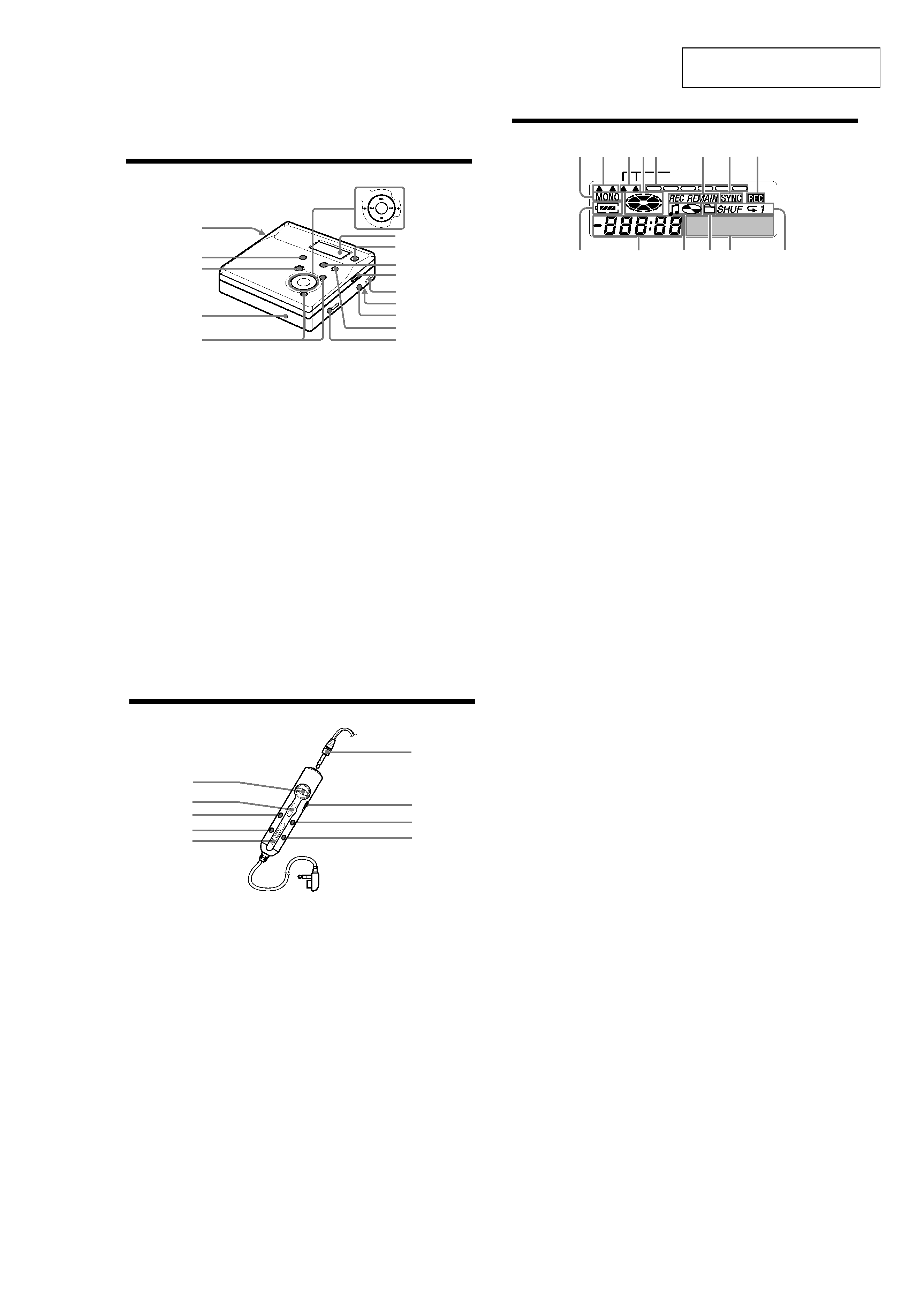
SERVICE MANUAL
PORTABLE MINIDISC RECORDER
US Model
Canadian Model
AEP Model
UK Model
E Model
Australian Model
Chinese Model
SPECIFICATIONS
MZ-N505
US and foreign patents licensed from Dolby
Laboratories.
Continued on next page
Model Name Using Similar Mechanism
MZ-N707
Mechanism Type
MT-MZN707-177
Optical Pick-up Name
LCX-5R
Ver 1.2 2003. 08
9-873-459-03
Sony Corporation
2003H05-1
Personal Audio Company
C
2003.08
Published by Sony Engineering Corporation
· OpenMG, "MagicGate", "MagicGate Memory Stick", "Memory Stick",
VAIO,MusicClip and their logos are trademarks of Sony Corporation.
· "WALKMAN" is a trademark of Sony Corporation.
· Microsoft,Windows,Windows NT and Windows Media are trademarks
or registered trademarks of Microsoft Corporation in the United States
and/or other countries.
· IBM and PC/AT are registered trademarks of International Business
Machines Corporation.
· Macintosh is a trademark of Apple Computer,Inc.in the United States
and/or other countries.
· All other trademarks are trademarks of their respective owners. TM and
® marks are omitted in this manual.
MD Recorder
Audio playing system
MiniDisc digital audio system
Laser diode properties
Material: GaAlAs MQW
Wavelength:
= 790 nm
Emission duration: continuous
Laser output: less than 44.6
µW
(This output is the value measured at a distance
of 200 mm from the lens surface on the optical
pick-up block with 7 mm aperture.)
Recording and playback time
When using MDW-80
Maximum 160 min. in monaural
Maximum 320 min. in stereo
Revolutions
Approx. 380 rpm to 2,700 rpm (CLV)
Error correction
ACIRC (Advanced Cross Interleave Reed
Solomon Code)
Sampling frequency
44.1 kHz
Sampling rate converter
Input: 32 kHz/44.1 kHz/48 kHz

2
MZ-N505
General
Power requirements
Sony AC Power Adaptor (supplied) connected
at the DC IN 3 V jack (country model in
parentheses):
Nickel Cadmium rechargeable battery NC-
WMAA (except US and Canadian models supplied)
LR6 (size AA) alkaline battery (not supplied)
Dimensions
Approx. 81
× 27.9 × 74.4 mm (w/h/d) (31/4 ×
11/8
× 3 in.) without projections.
Mass
Approx. 104 g (3.7 oz) the recorder only
Design and specifications are subject to change
without notice.
Supplied accessories
NC-WMAA Nickel Cadmium rechargeable ba
(except US and Canadian models) (1)
ttery
AC power adaptor (1)
Headphones/earphones (1)
Op
Remote control (except US and Canadian models) (1)
tical cable (except US and Canadian models) (1)
USB cable (1)
Battery carrying case (except US and Canadian models) (1)
Carrying case with a belt clip (European model only) (1)
C
Minidisc (blank) (US and Canadian models only) (1)
D-ROM (1)*
Do not play a CD-ROM on an audio CD player.
Battery life 1)
When recording 2)
(Unit: approx.hours)(JEITA3))
1) The battery life may be shorter due to operating
conditions, the temperature of the location, and
varieties of batteries.
2) When you record, use a fully charged
rechargeable battery. Recording time may
differ according to the alkaline batteries.
3) Measured in accordance with the JEITA (Japan
Electronics and Information Technology
Industries Association) standard.
Batteries
SP
Stereo
LP2
Stereo
LP4
Stereo
NC-WMAA
Nickel
Cadmium
rechargeable
battery4)
4) When using a 100% fully charged rechargeable
battery.
46
7.5
LR6 (SG)
Sony alkaline
dry battery5)
5) When using a Sony LR6 (SG) "STAMINA "
alkaline dry battery (produced in Japan).
91 3
16
When playing
(Unit: approx.hours)(JEITA1))
Batteries
SP
Stereo
LP2
Stereo
LP4
Stereo
NC-WMAA
Nickel
Cadmium
rechargeable
battery2)
15
16
20
LR6 (SG)
Sony alkaline
dry battery3)
42
48
56
1) Measured in accordance with the JEITA
(Japan Electronics and Information
Technology Industries Association) standard.
2) When using a 100% fully charged
rechargeable battery.
3) When using a Sony LR6 (SG) "STAMINA "
alkaline dry battery (produced in Japan).
Coding
ATRAC (Adaptive TRansform Acoustic
Coding)
AT RAC3 -- LP2/LP4
Modulation system
EFM (Eight to Fourteen Modulation)
Number of channels
2 stereo channels
1 monaural channel
Frequency response
20 to 20,000 Hz
± 3 dB
Wow and Flutter
Below measurable limit
Inputs
Line in: stereo mini-jack, minimum input level
49 mV
Optical (Digital) in: optical (digital) mini-jack
Outputs
i: stereo mini-jack, maximum output level
5 mW + 5 mW, load impedance 24 ohm (US model only)
5 mW + 5 mW, load impedance 16 ohm (except US model)
120 V AC, 60 Hz (USA, Canada and
Taiwan)
230 V AC, 50/60 Hz (Continental Europe)
240 V AC, 50 Hz (Australia)
220 V AC, 50 Hz (China)
230 - 240 V AC, 50 Hz (UK and Hong
Kong)
110/220 V AC, 60 Hz (Korea)
100 - 240 V AC, 50/60 Hz (Other countries)
SAFETY-RELATED COMPONENT WARNING!!
COMPONENTS IDENTIFIED BY MARK 0 OR DOTTED
LINE WITH MARK 0 ON THE SCHEMATIC DIAGRAMS
AND IN THE PARTS LIST ARE CRITICAL TO SAFE
OPERATION. REPLACE THESE COMPONENTS WITH
SONY PARTS WHOSE PART NUMBERS APPEAR AS
SHOWN IN THIS MANUAL OR IN SUPPLEMENTS PUB-
LISHED BY SONY.
ATTENTION AU COMPOSANT AYANT RAPPORT
À LA SÉCURITÉ!
LES COMPOSANTS IDENTIFIÉS PAR UNE MARQUE 0
SUR LES DIAGRAMMES SCHÉMATIQUES ET LA LISTE
DES PIÈCES SONT CRITIQUES POUR LA SÉCURITÉ
DE FONCTIONNEMENT. NE REMPLACER CES COM-
POSANTS QUE PAR DES PIÈCES SONY DONT LES
NUMÉROS SONT DONNÉS DANS CE MANUEL OU
DANS LES SUPPLÉMENTS PUBLIÉS PAR SONY.
Ver 1.1

3
MZ-N505
TABLE OF CONTENTS
1.
SERVICING NOTES ............................................... 4
2.
GENERAL ................................................................... 5
3.
DISASSEMBLY
3-1. Disassembly Flow ...........................................................
6
3-2. Case (Lower) ...................................................................
7
3-3. Case (Upper) Section ......................................................
7
3-4. LCD Module, Case (Upper) Sub Assy ...........................
8
3-5. Mechanism Deck (MT-MZN707-177) ...........................
8
3-6. Set Chassis (5188) Assy ..................................................
9
3-7. MAIN Board ...................................................................
9
3-8. OP Service Assy (LCX-5R) ............................................ 10
3-9. Holder Assy ..................................................................... 11
3-10. DC Motor (Sled) (M602) ................................................ 11
3-11. DC SSM18B Motor (Spindle) (M601),
DC Motor (Over Write Head Up/Down) (M603) .......... 12
4.
TEST MODE .............................................................. 13
5.
ELECTRICAL ADJUSTMENTS ......................... 19
6.
DIAGRAMS
6-1. Block Diagram SERVO/USB Section ...................... 32
6-2. Block Diagram AUDIO Section ............................... 33
6-3. Block Diagram DISPLAY/KEY CONTROL/
POWER SUPPLY Section ........................................... 34
6-4. Note for Printed Wiring Board and
Schematic Diagrams ....................................................... 35
6-5. Printed Wiring Board
MAIN Board (Component Side) ............................. 36
6-6. Printed Wiring Board
MAIN Board (Conductor Side) ............................... 37
6-7. Schematic Diagram MAIN Board (1/4) .................. 38
6-8. Schematic Diagram MAIN Board (2/4) .................. 39
6-9. Schematic Diagram MAIN Board (3/4) .................. 40
6-10. Schematic Diagram MAIN Board (4/4) .................. 41
6-11. IC Pin Function Description ........................................... 48
7.
EXPLODED VIEWS
7-1. Case Section .................................................................... 55
7-2. Chassis Section ............................................................... 56
7-3. MAIN Board Section ...................................................... 57
7-4. Mechanism Deck Section-1 (MT-MZN707-177) ........... 58
7-5. Mechanism Deck Section-2 (MT-MZN707-177) ........... 59
8.
ELECTRICAL PARTS LIST ............................... 60
CAUTION
Use of controls or adjustments or performance of procedures
other than those specified herein may result in hazardous ra-
diation exposure.
Notes on chip component replacement
· Never reuse a disconnected chip component.
· Notice that the minus side of a tantalum capacitor may be dam-
aged by heat.
Flexible Circuit Board Repairing
· Keep the temperature of the soldering iron around 270 °C dur-
ing repairing.
· Do not touch the soldering iron on the same conductor of the
circuit board (within 3 times).
· Be careful not to apply force on the conductor when soldering
or unsoldering.
UNLEADED SOLDER
Boards requiring use of unleaded solder are printed with the lead-
free mark (LF) indicating the solder contains no lead.
(Caution: Some printed circuit boards may not come printed with
the lead free mark due to their particular size)
: LEAD FREE MARK
Unleaded solder has the following characteristics.
· Unleaded solder melts at a temperature about 40 °C higher than
ordinary solder.
Ordinary soldering irons can be used but the iron tip has to be
applied to the solder joint for a slightly longer time.
Soldering irons using a temperature regulator should be set to
about 350 °C .
Caution: The printed pattern (copper foil) may peel away if the
heated tip is applied for too long, so be careful!
· Strong viscosity
Unleaded solder is more viscous (sticky, less prone to flow) than
ordinary solder so use caution not to let solder bridges occur
such as on IC pins, etc.
· Usable with ordinary solder
It is best to use only unleaded solder but unleaded solder may
also be added to ordinary solder.
On power sources
·Use house current, Nickel Cadmium
rechargeable battery, LR6 (size AA) battery,
or car battery.
·For use in your house: Use the AC power
adaptor supplied with this recorder. Do not
use any other AC power adaptor since it may
cause the recorder to malfunction.
Polarity of the
plug

4
MZ-N505
NOTES ON HANDLING THE OPTICAL PICK-UP
BLOCK OR BASE UNIT
The laser diode in the optical pick-up block may suffer electro-
static break-down because of the potential difference generated
by the charged electrostatic load, etc. on clothing and the human
body.
During repair, pay attention to electrostatic break-down and also
use the procedure in the printed matter which is included in the
repair parts.
The flexible board is easily damaged and should be handled with
care.
NOTES ON LASER DIODE EMISSION CHECK
Never look into the laser diode emission from right above when
checking it for adjustment. It is feared that you will lose your sight.
NOTES ON HANDLING THE OPTICAL PICK-UP BLOCK
(LCX-5R)
The laser diode in the optical pick-up block may suffer electro-
static break-down easily. When handling it, perform soldering
bridge to the laser-tap on the flexible board. Also perform mea-
sures against electrostatic break-down sufficiently before the op-
eration. The flexible board is easily damaged and should be handled
with care.
OPTICAL PICK-UP FLEXIBLE BOARD
SECTION 1
SERVICING NOTES
· In performing the repair with the power supplied to the set, re-
moving the MAIN board causes the set to be disabled.
In such a case, fix a convex part of the open/close detect switch
(S806 on MAIN board) with a tape in advance.
Handle the FLEXIBLE board (overwrite head) with care, as it
has been soldered directly to the MAIN board.
In repairing the component side of MAIN board, connect the
FLEXIBLE board (overwrite head) and the MAIN board with
the lead wires in advance.
laser-tap
·The shipment data will be cleared when the NV is reset. There-
fore, change the NV adjusted values following the Change of
NV Adjusted Values immediately after the NV was reset. (See
page 19)
·The set having the microcomputer version 1.100 to 1.300 re-
quires the patch data in the nonvolatile memory (IC804) to be
rewritten using the application, when the MAIN board was re-
placed. (See page 29)
On the set having the microcomputer version 1.400 or later, re-
writing the patch data is unnecessary.
· Replacement of CXD2677-205GA (IC801) used in this set re-
quires a special tool.
System requirements
· IBM PC/AT or Compatible (The software does not run on Macintosh.)
CPU: MMXTM Pentium® 233 MHzor higher (Pentium® II 400 MHzor higher is
recommended.)
Hard disk drive space: 60 MB or more (The amount of necessary space depends on
the version of the Windows OS or the size of your audio files.)
RAM: 64 MB or higher (128 MB or higher is recommended for Windows® XP Home
Edition/Windows® XP Professional.)
CD-ROM drive (capable of digitalplayback by WDM)
Sound Board
USB port (supports USB 2.0 Full Speed (previouslyUSB 1.1))
· Operating System: Windows® 98/Windows® 98 Second Edition/Windows® 2000
Professional/Windows® Me/Windows® XP Home Edition/Windows® XP
Professional (manufacturer installed)
The NTFS format of Windows® 2000 Professional, Windows® XP Home Edition, or
Windows® XP Professional (manufacturer-installed)is supported only when used
withthe standard (factory) settings.
This software is not supported by the following environments.
Windows® 95, Windows® NT, or other versions of Windows® NT (such as Server)
An environment that is an upgrade of the original manufacturer-installed
operating system, as in the followingexamples:
Windows® 3.1/Windows® 95 t Windows® 98 (or Windows® 98 Second Edition/
Windows® Me)
Windows® Me/Windows® 2000 Professionalt Windows® XP
Multi-bootenvironmentwithWindows ® 2000 (or Windows® XP) and Windows®
98 (or Windows® 98 Second Edition/
Windows ® Me)
· Display: High(16bit) Color or more (800
× 480 dot or more)
· Internet access: for Web registration and EMD services
· Windows
· Internet access: for sfortware upgrades and CDDB2 use. (US and Canadian models)
Media Player (version 7.0 or higher) installed for playingWMAfiles.
Notes
· Trouble-free operation is not assured withina multiple-monitorenvironment.
· We do not assure trouble-free operation for all computers satisfying the system requirements.
· Trouble-free operation is not guaranteed followingthe self-conducted upgrade of home-built
PCs or operating systems.
· We do not assure trouble-free operation of the system suspend, sleep, or hibernationfunctionon
all computers.
· For details, refer to "Net MDHelp " of the online help.
Note
The optical digitaloutputconnector (on computers providedwithone) may be disabled
duringplayback for the protection of copyrights.
Notes on using OpenMG Jukebox with Windows
2000/Windows XP
If your computer is Windows 2000 Professional, Windows XP Home Edition, or
Windows XP Professional, please be aware of the following before instaling OpenMG
Jukebox.
1 With Windows 2000 Professional, you must log on as "Administrators" (or with the
user name "Administrator") to install OpenMG Jukebox.
2 With Windows XP Home Edition or Windows XP Professional, you must log on
with user name "Computer Administrator" to install OpenMG Jubebox. To check
whether a user name has the attribute of "Computer Administrator" or not, go to
[Control Panel] - [User Account].
Notes on using OpenMG Jukebox with Windows XP/
Windows Me
If Windows XP/Windows Me is installed in your computer, and you perform the
"System Restore" function of the Windows "System Tools," the songs managed by
OpenMG Jukebox may become corrupted and rendered unplayable.
Therefore, before executing "System Restore," back up the songs using "OpenMG
Jukebox Backup Tool" first.
Then, after the "System Restore" function is finished, restore the songs using
"OpenMG Jukebox Backup Tool" to ensure the integrity and reliability of song
playback.
For more information about backup, refer to the online Help for OpenMG Jukebox.
Note
When songs become unplayable by executing "System Restore," an error dialog box may be
displayed. In this case, follow the displayed messages.
case (upper)
MAIN board
tape
S806
FLEXIBLE board
(over write head)
Ver 1.2

5
MZ-N505
SECTION 2
GENERAL
This section is extracted from
instruction manual.
10
Looking at the controls
The recorder
A OPEN button
B END SEARCH button
C X (pause) button
D DC IN 3V jack
E VOL +/ button
The VOL + button has a tactile dot.
F N (play) button
The N button has a tactile dot.
./> (search/AMS) button
x (stop)/CHARGE button
G Display window
H GROUP/CANCEL button
I T MARK/REC button
J HOLD switch
K USB connecting jack
L Battery compartment
M LINE IN (OPTICAL) jack
N MENU/ENTER button
O i (headphones/earphones) jack
2
3
4
qa
qs
qd
qf
qg
7
8
6
9
q;
5
1
CHARGE
11
The display window of the recorder
A MONO (monaural) indication
B LP mode indication
C Mega bass indication
D Disc indication
Shows that the disc is rotating for
recording, playing or editing an MD.
E Level meter
Shows the volume of the MD being
played or recorded.
F REC REMAIN/REMAIN (remaining
time/tracks) indication
Lights up along with the remaining
time of the track, the remaining time
of the MD, or the remaining number
of tracks.
G SYNC (synchro-recording) indication
H REC indication
Lights up while recording. When
flashing, the recorder is in record
standby mode.
I Battery indication
Shows approximate battery condition.
J Time display
K Disc name/track name indication
Lights up when labeling a disc or a
track.
L Group indication
Lights up when group mode is on.
M Character information display
Displays the disc and track names,
error messages, track numbers, etc.
N Play mode indication
Shows play mode of the MD.
Digital MEGA BASS
LP 2 . 4
AB
C D E
F
G
H
J
I
M
L
KN
12
The headphones/earphones with a remote control
A ./>/N (search/AMS/play) ·
>/. button
B x (stop) · ENTER button
C X (pause) · CAPS button
D EDIT button
E VOL +/ button
F Headphones/earphones
Can be replaced with optional
headphones/earphones.
G HOLD switch
Slide to lock the controls of the
remote control.
H T MARK button
I DELETE button
B
A
C
D
E
G
F
I
H
